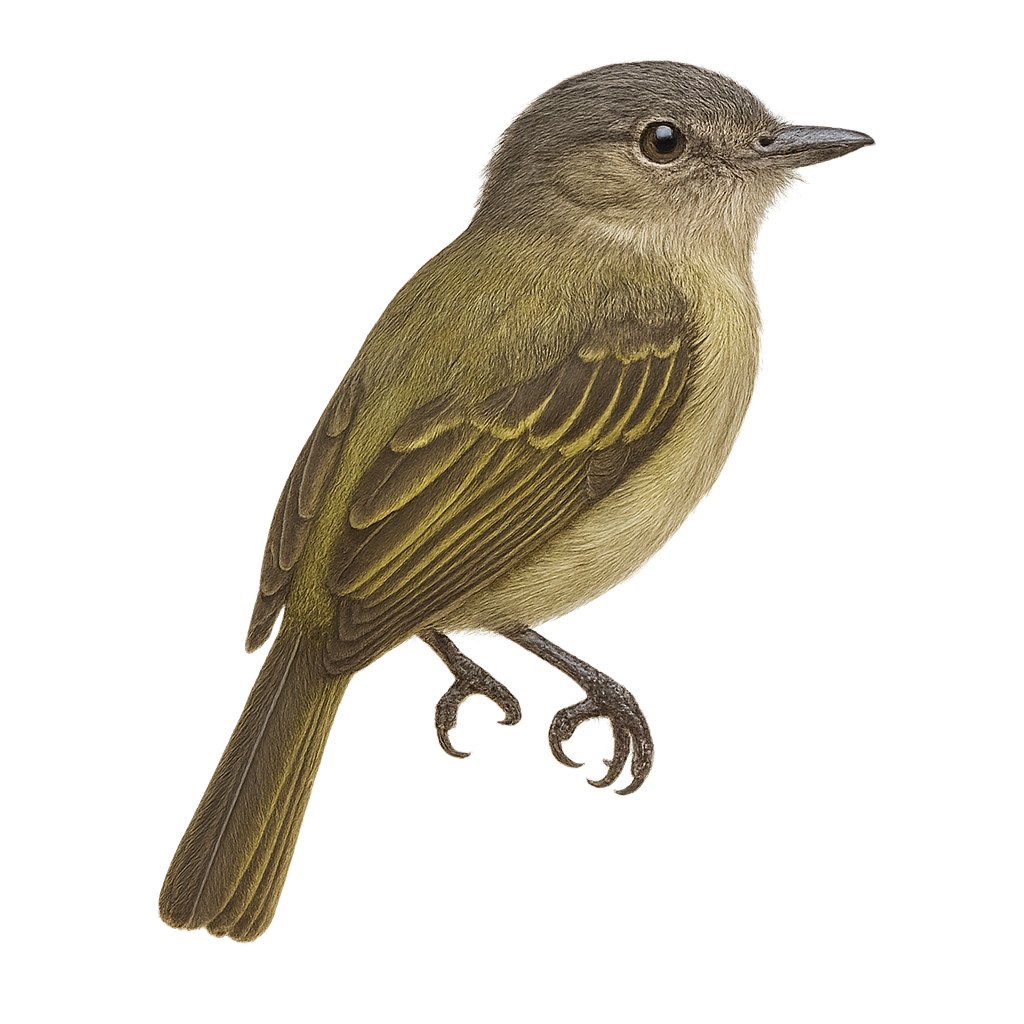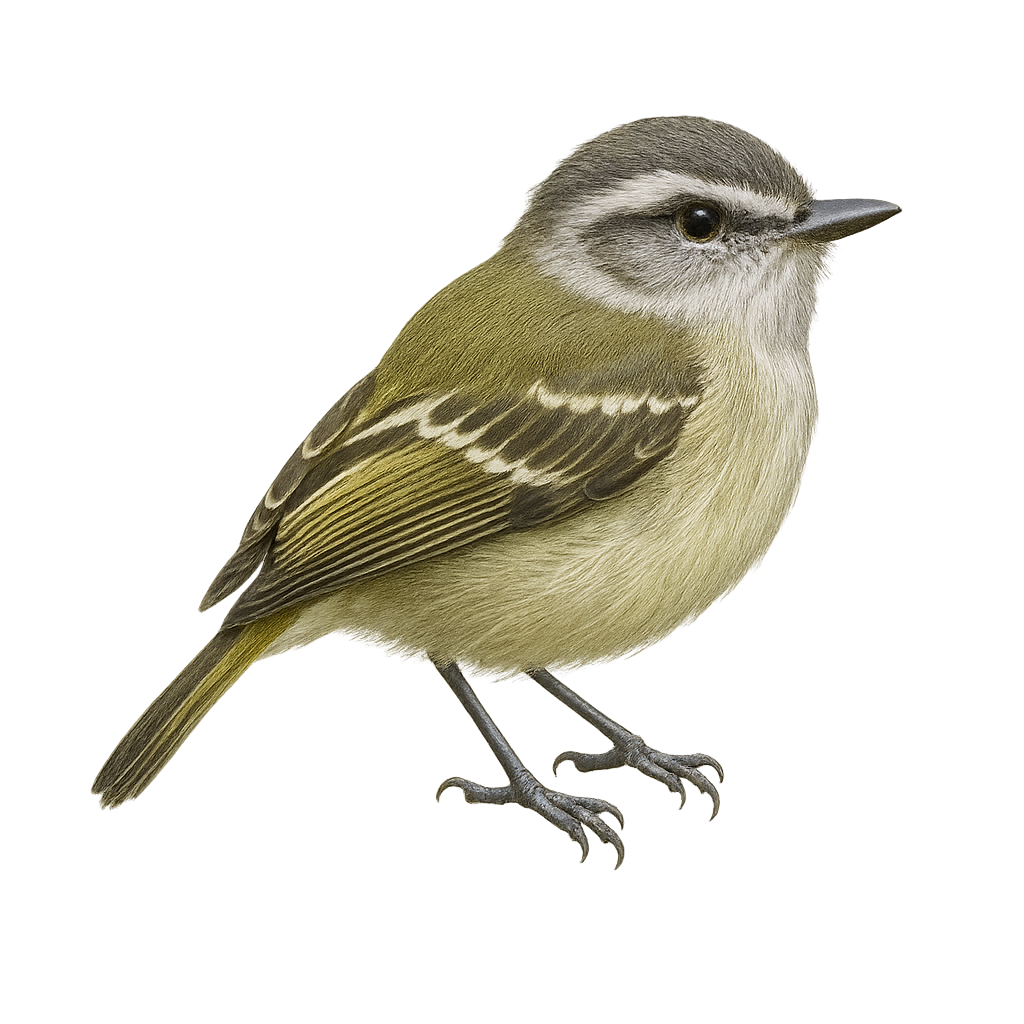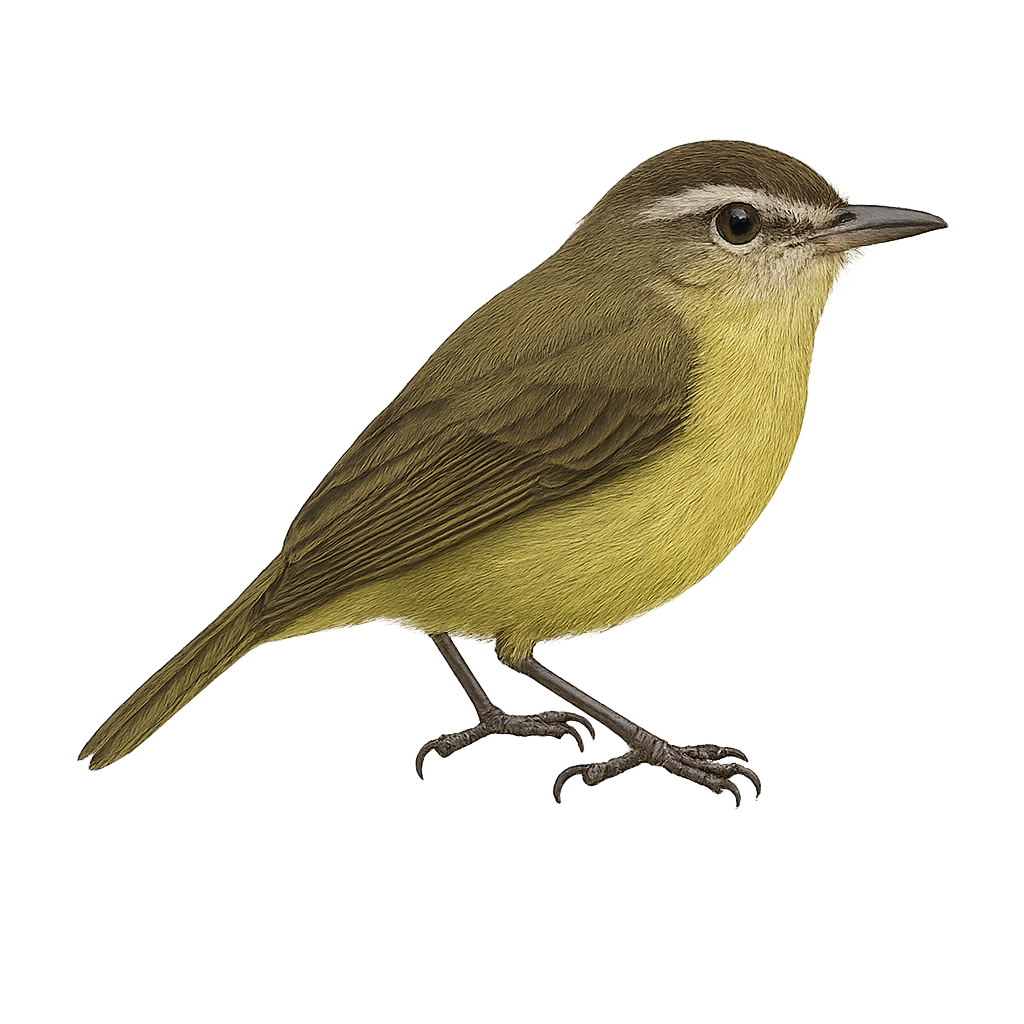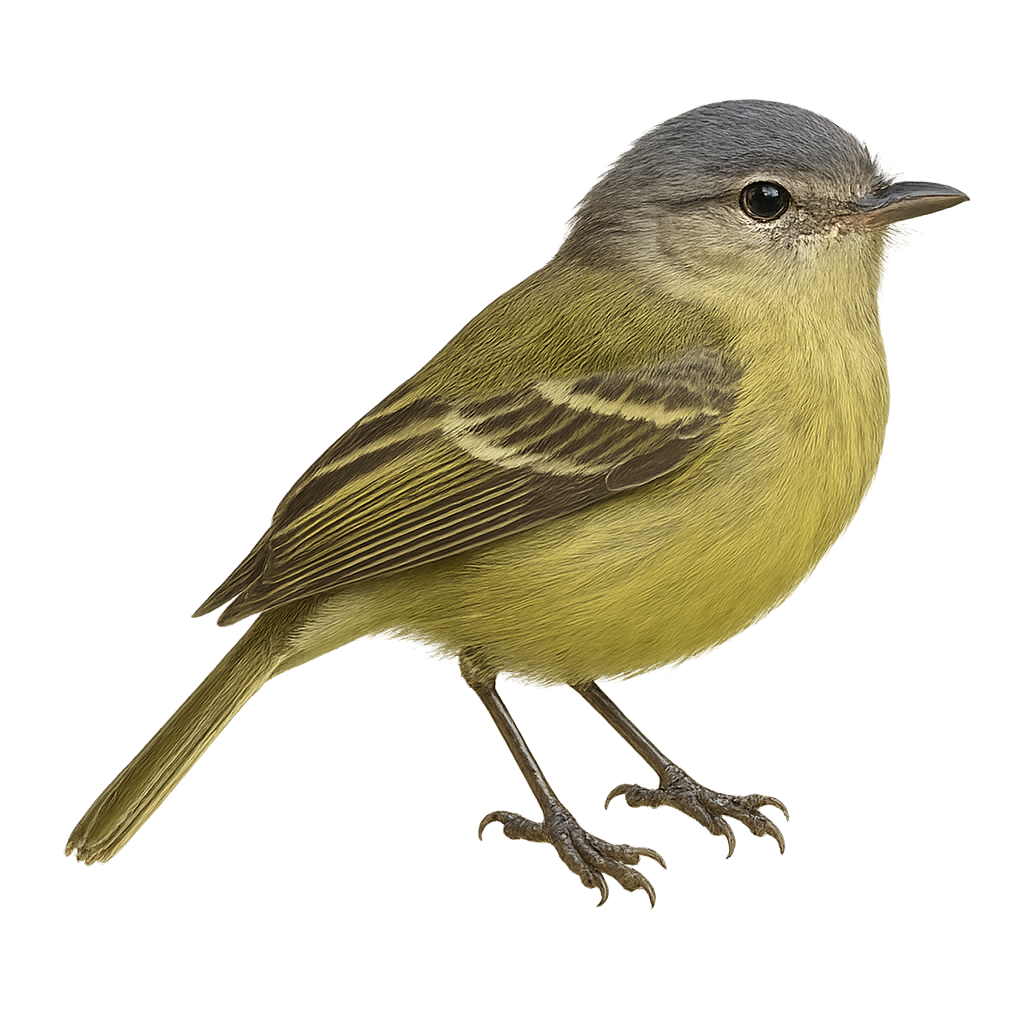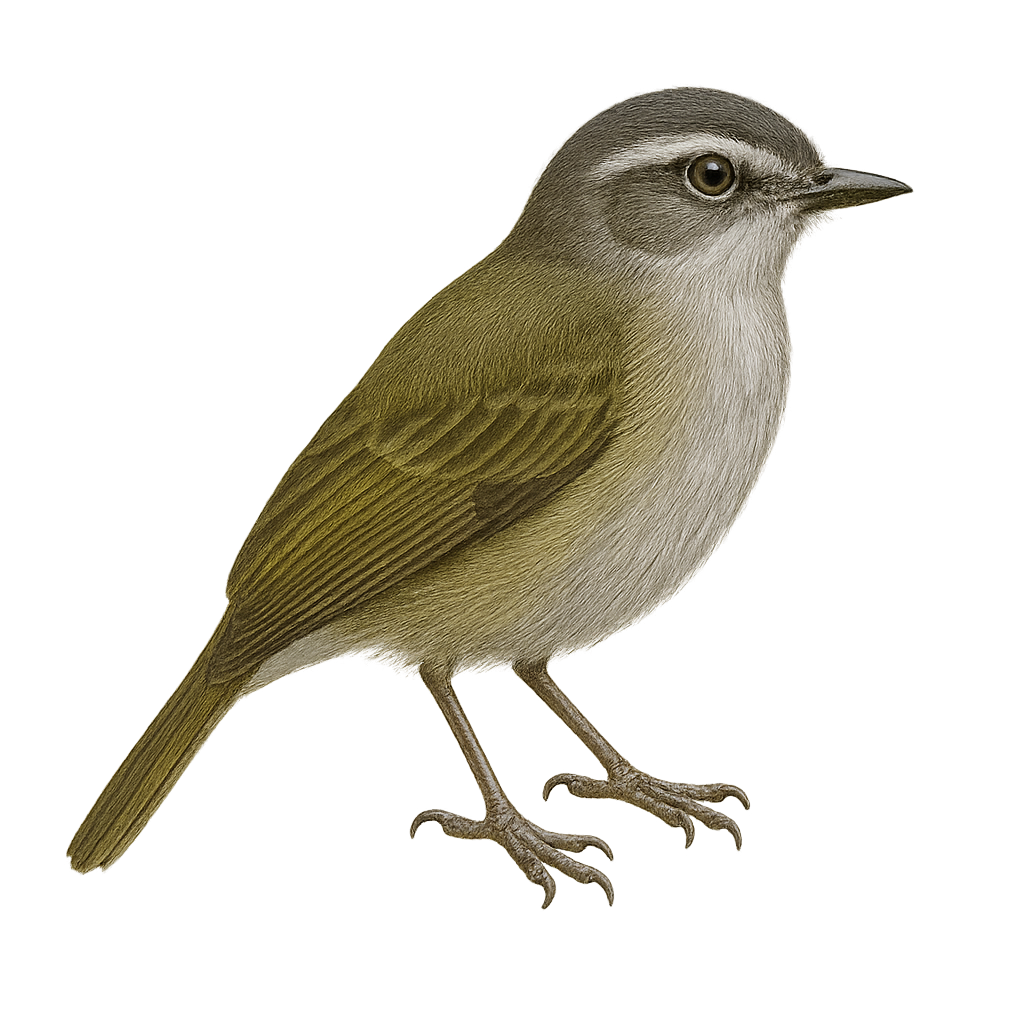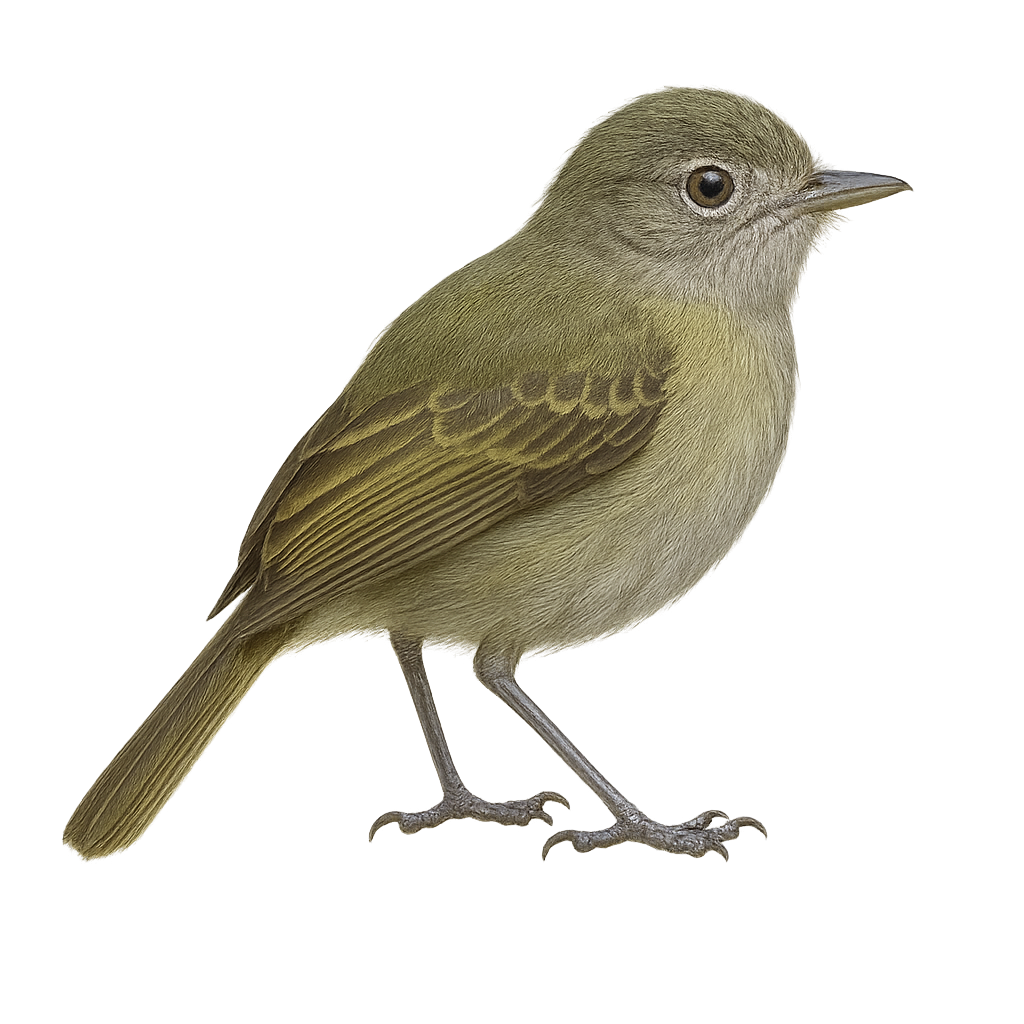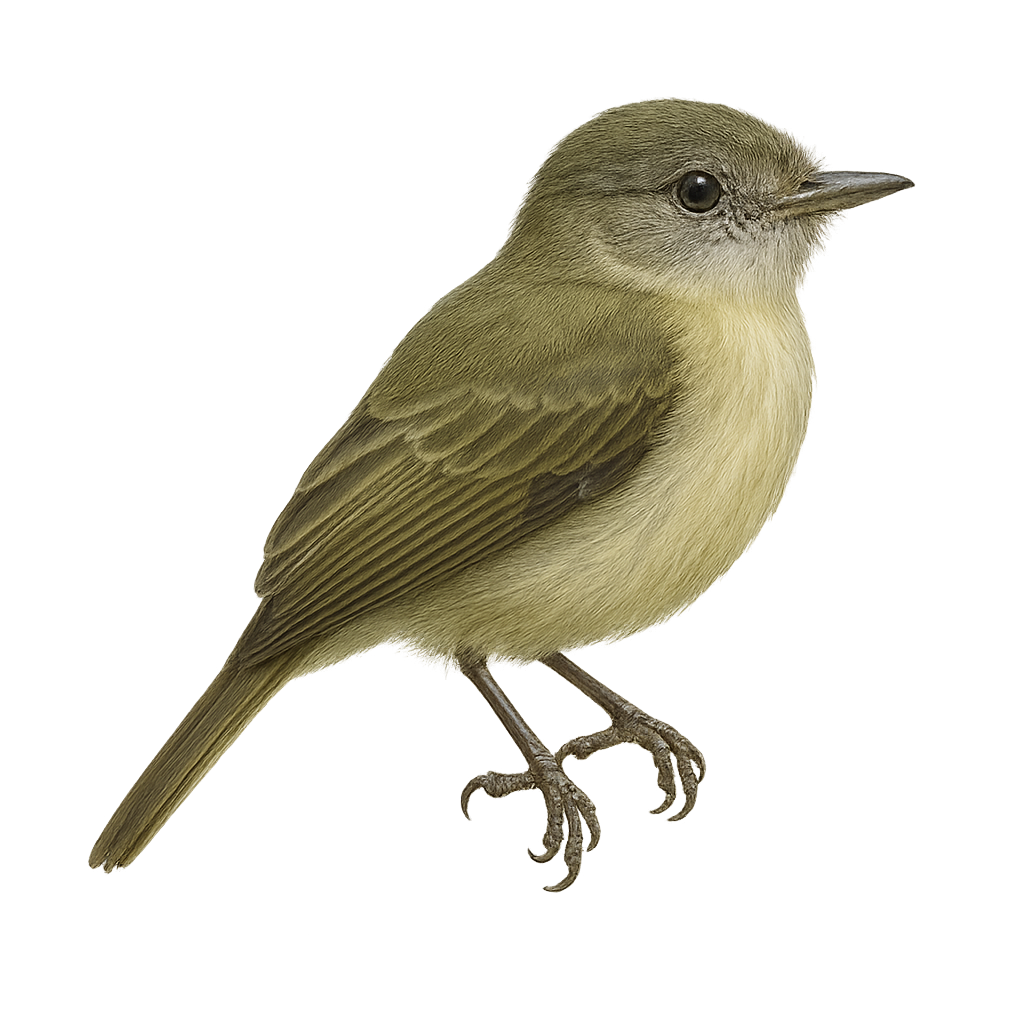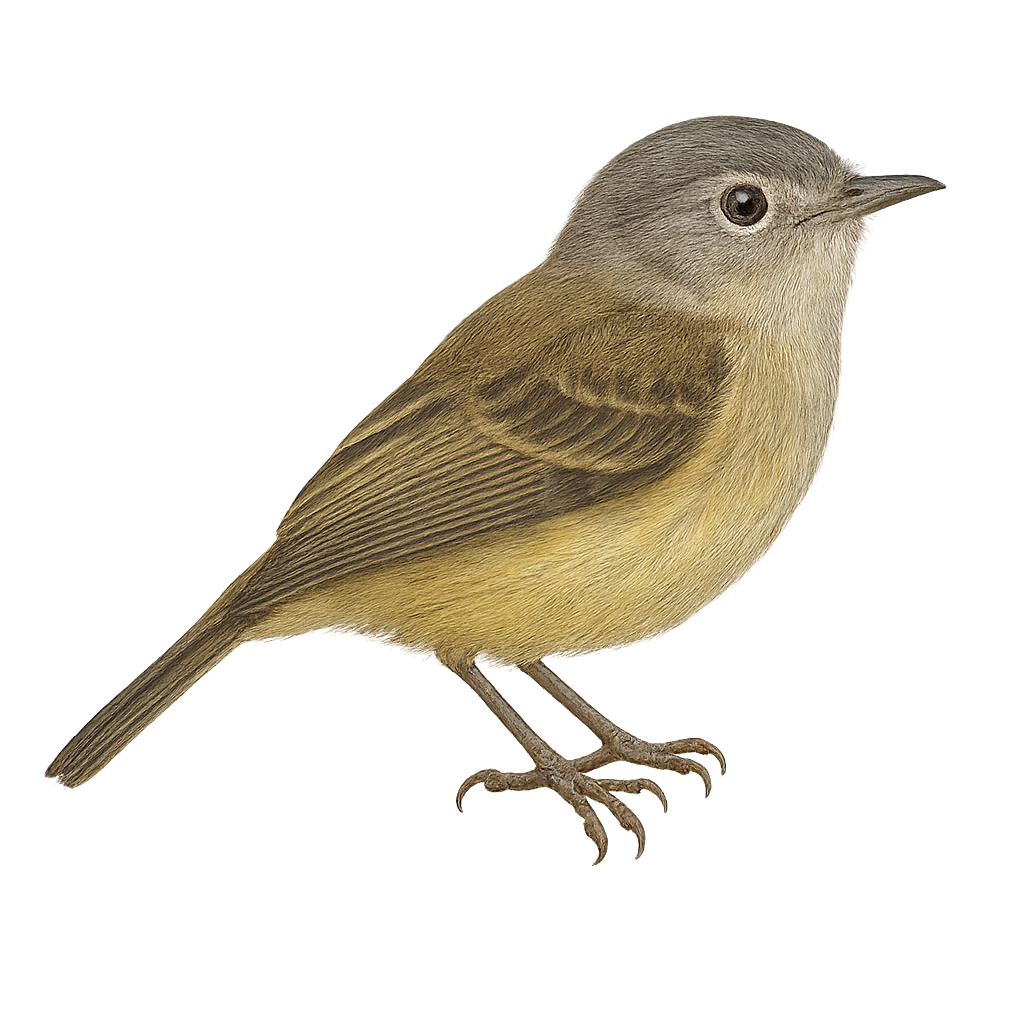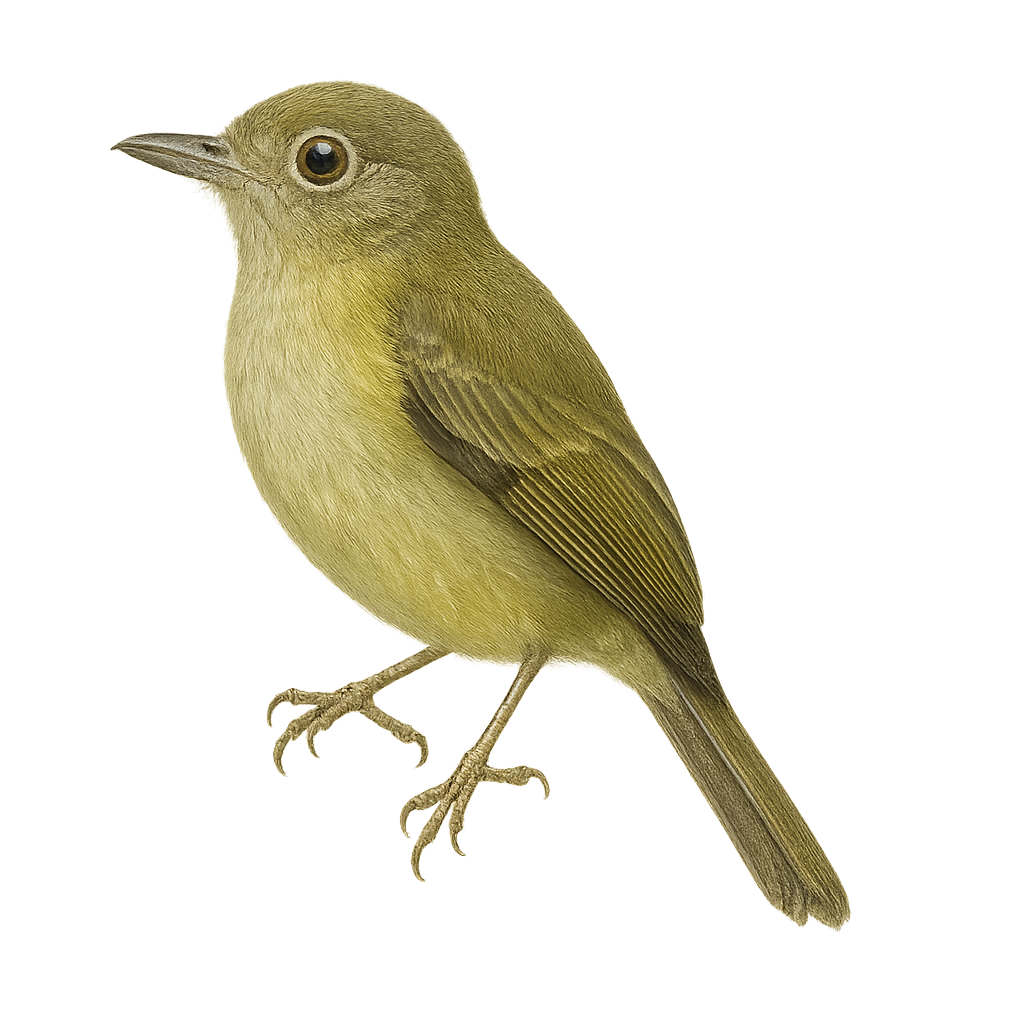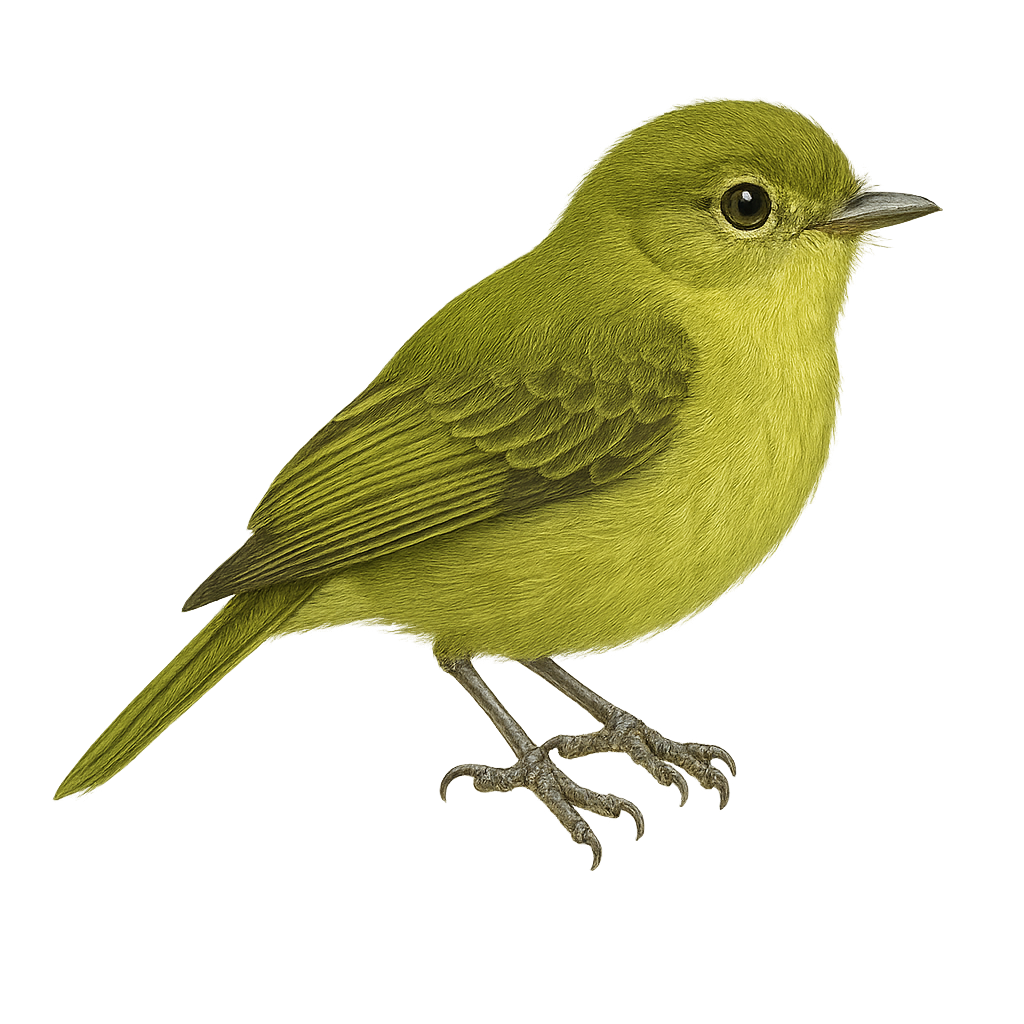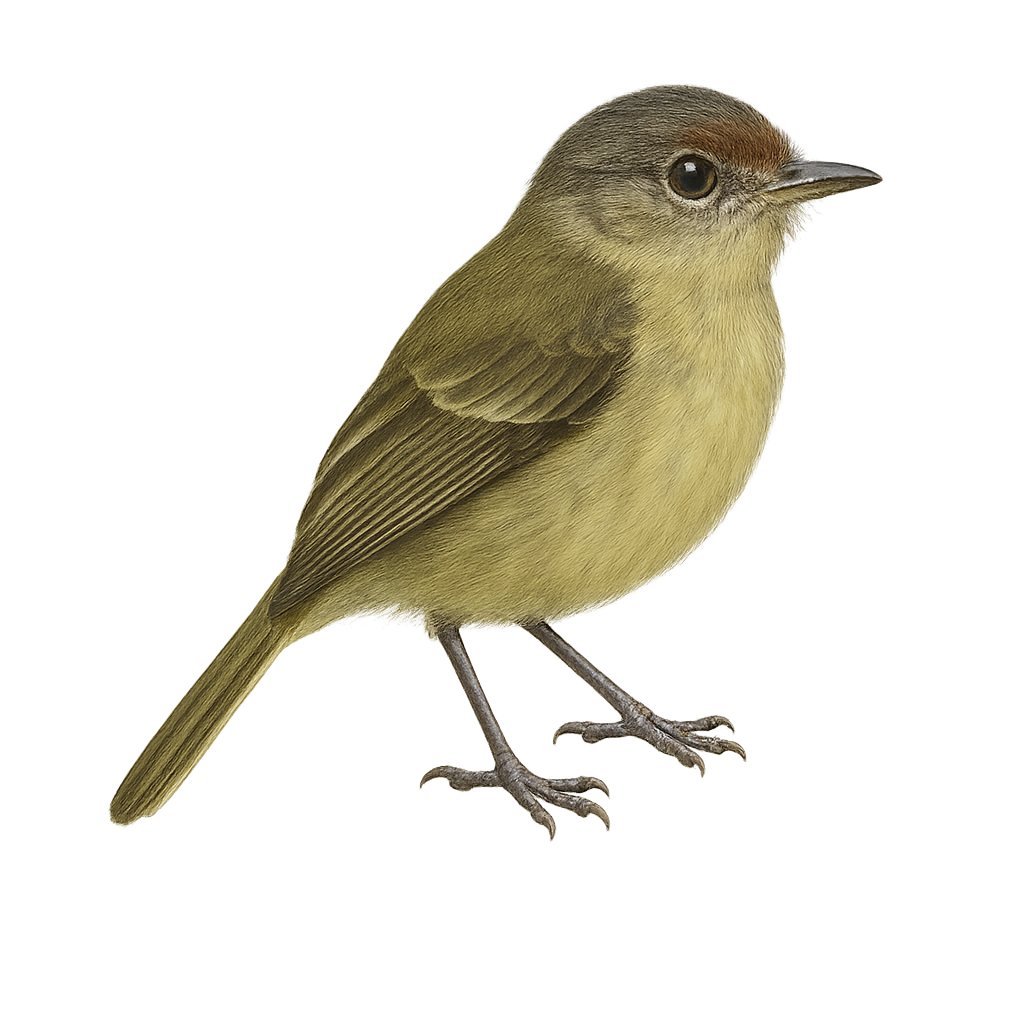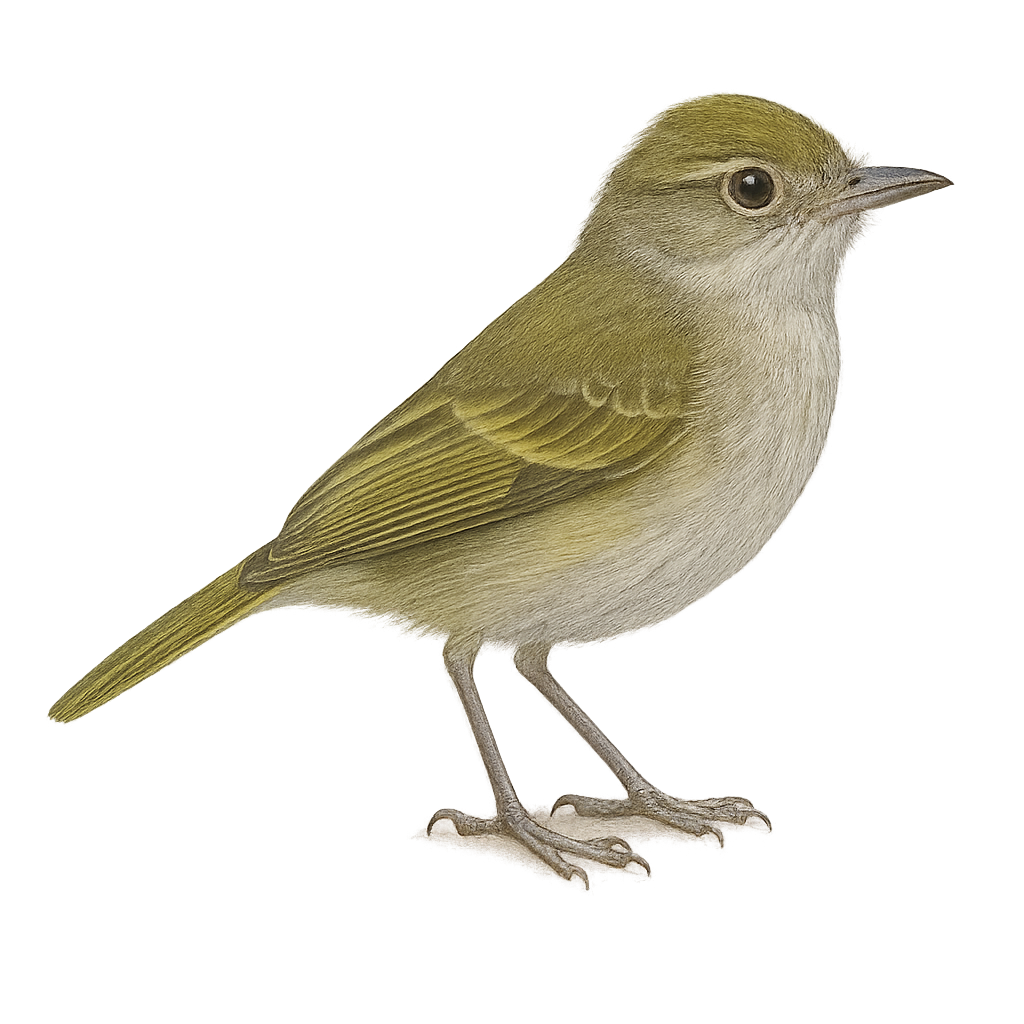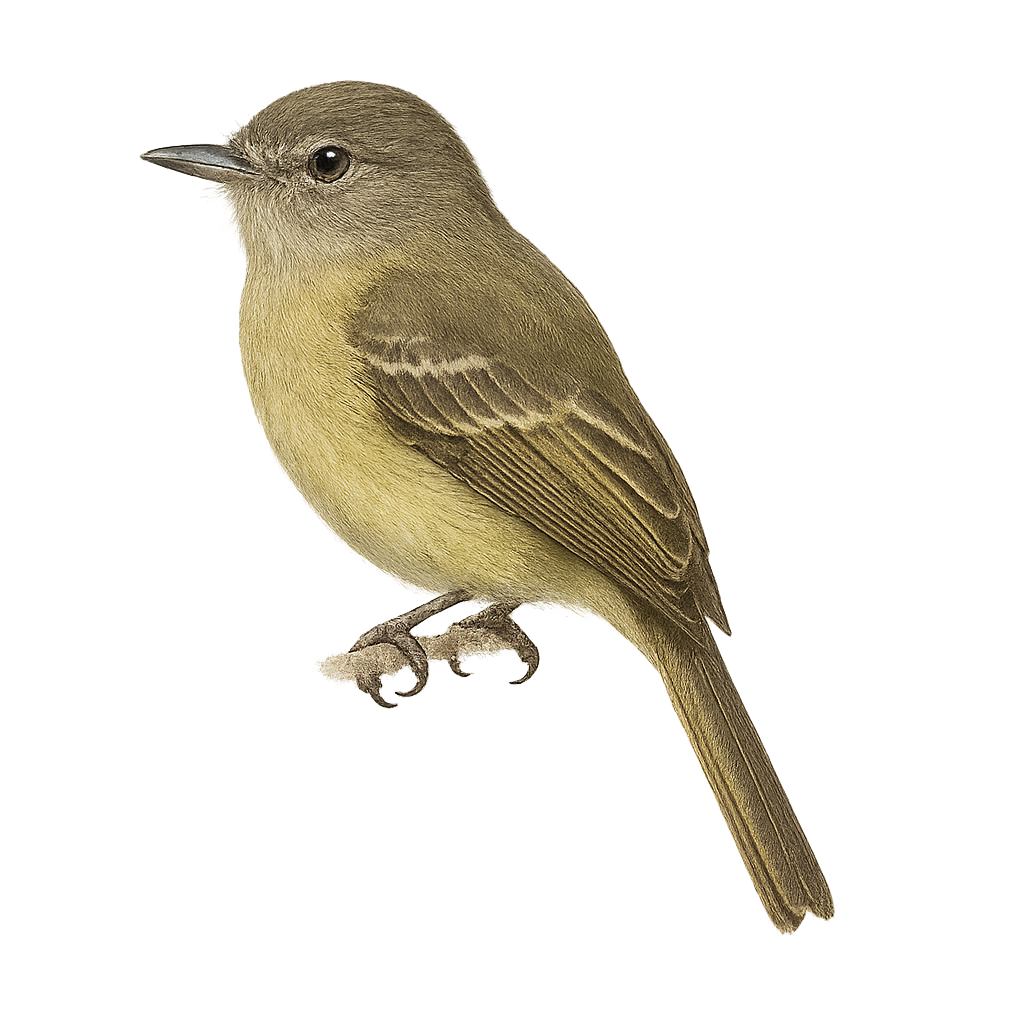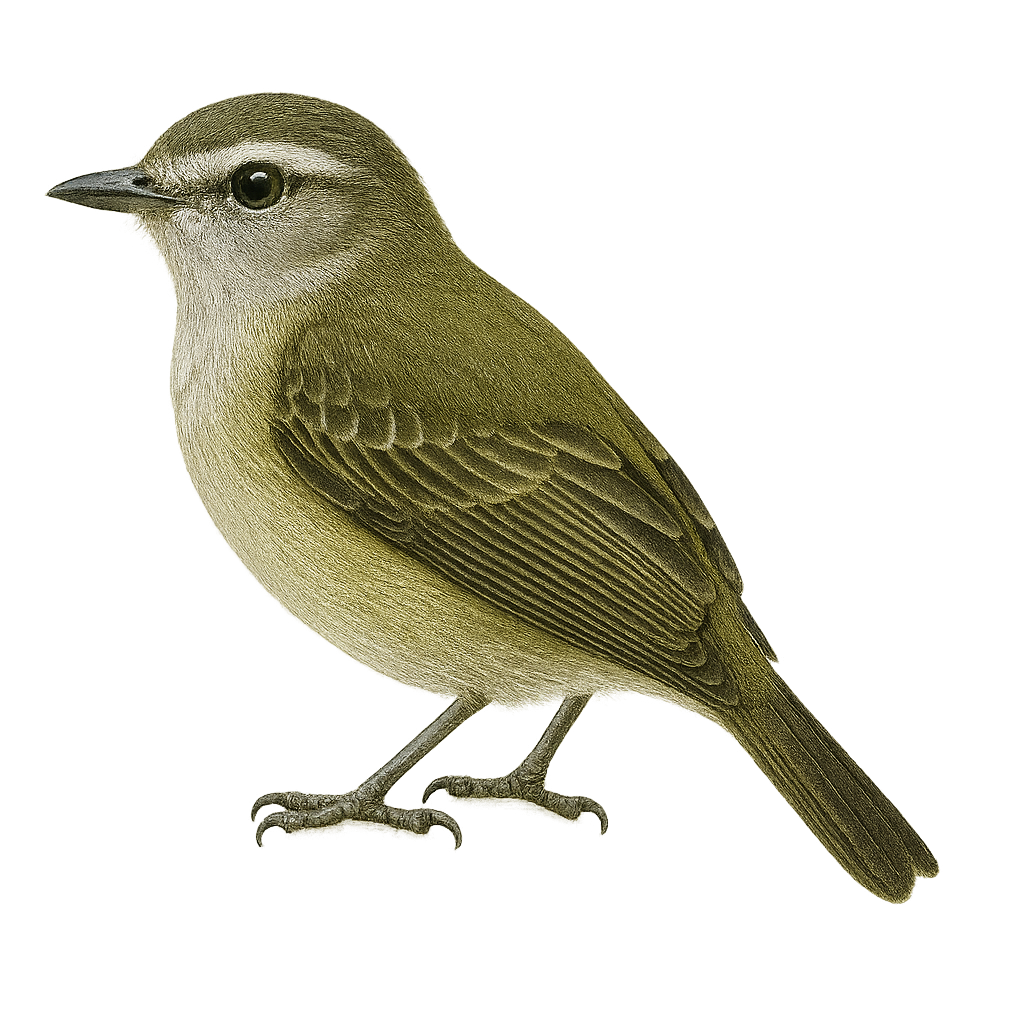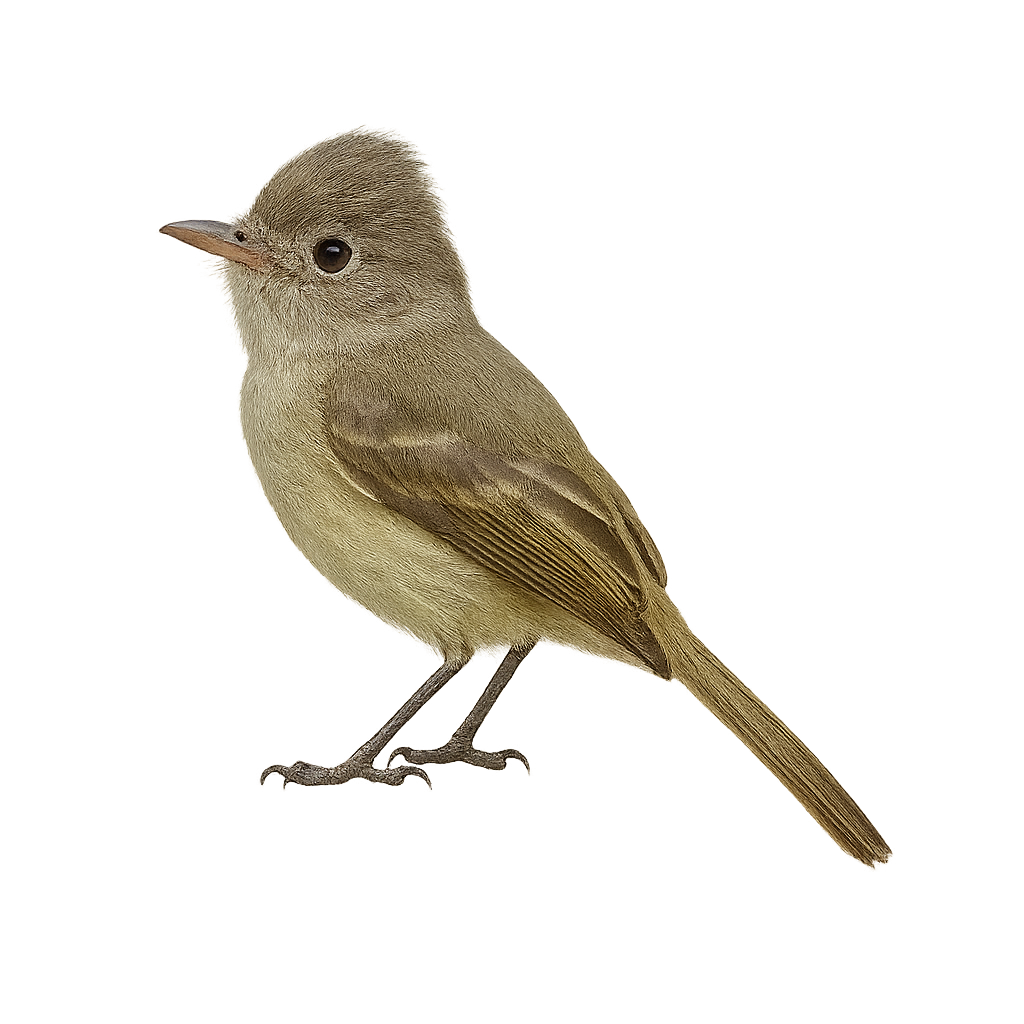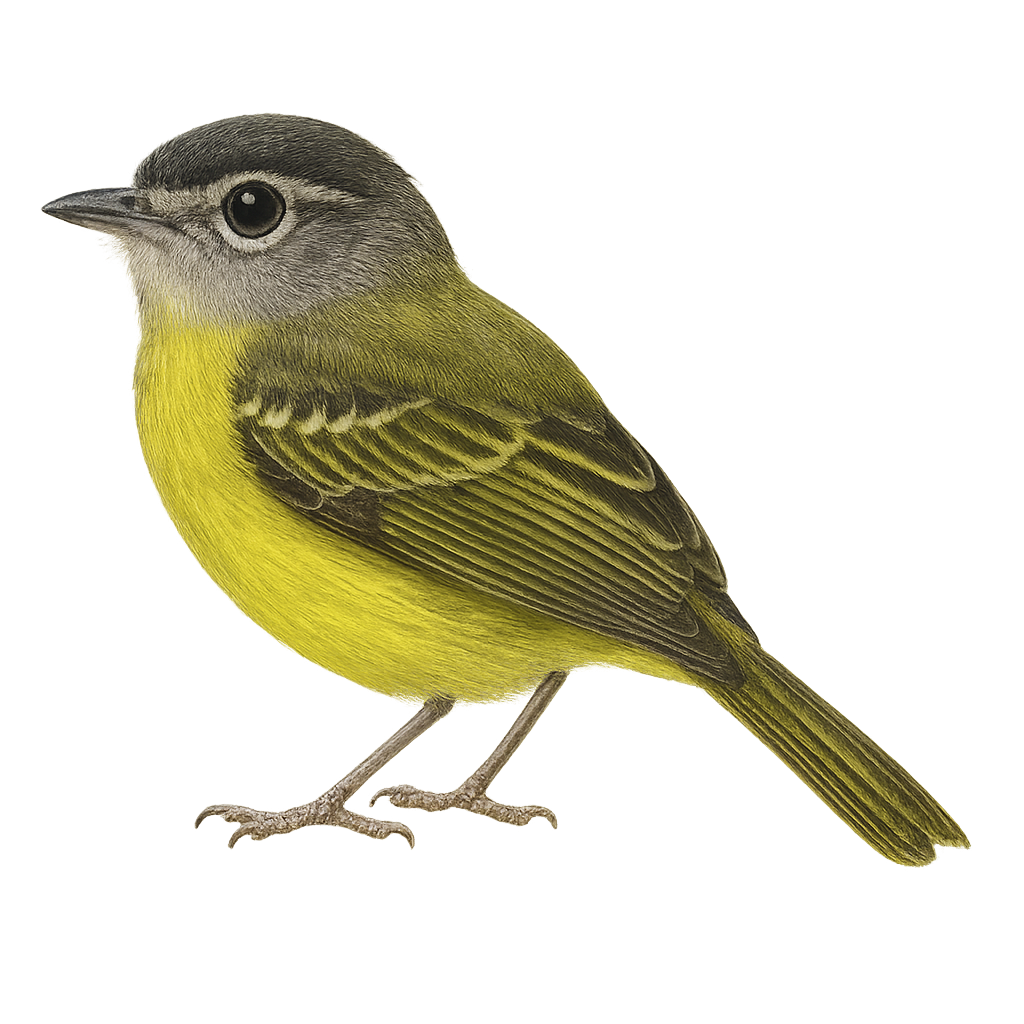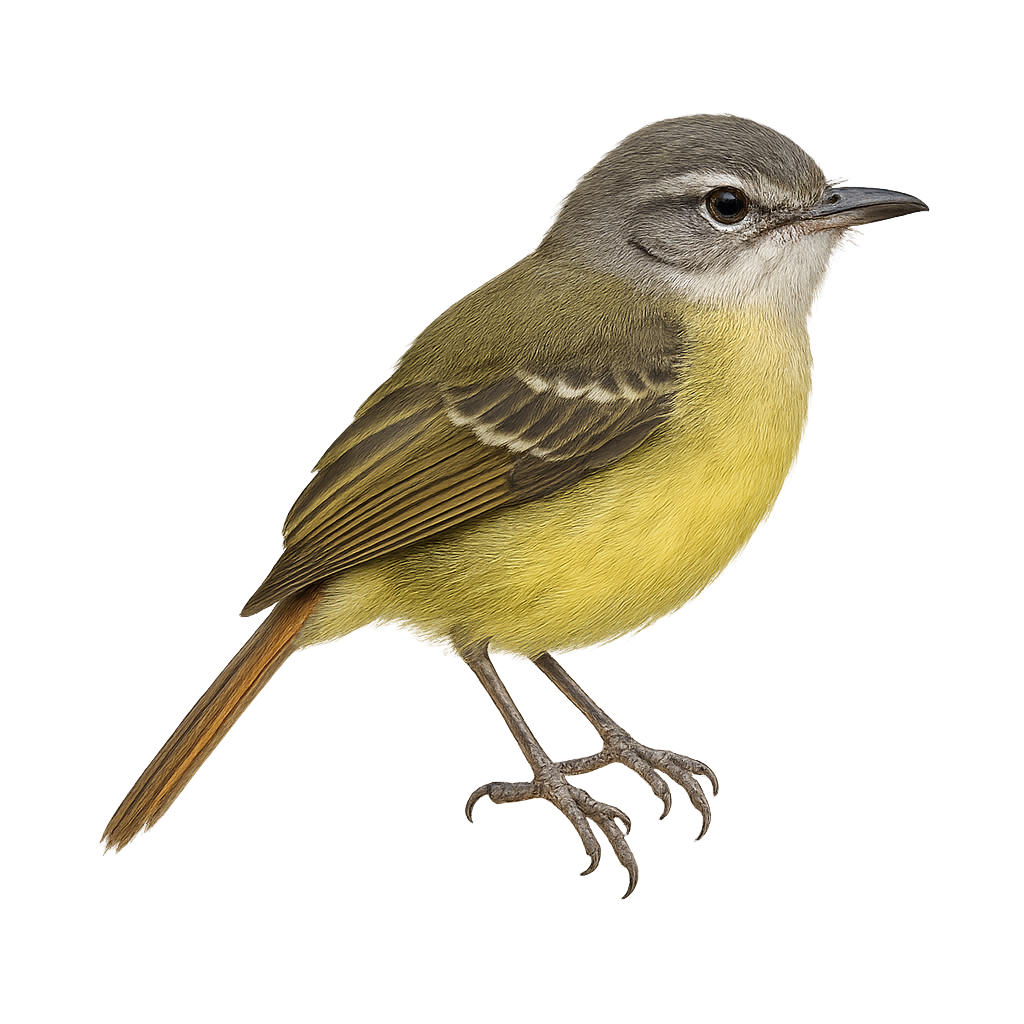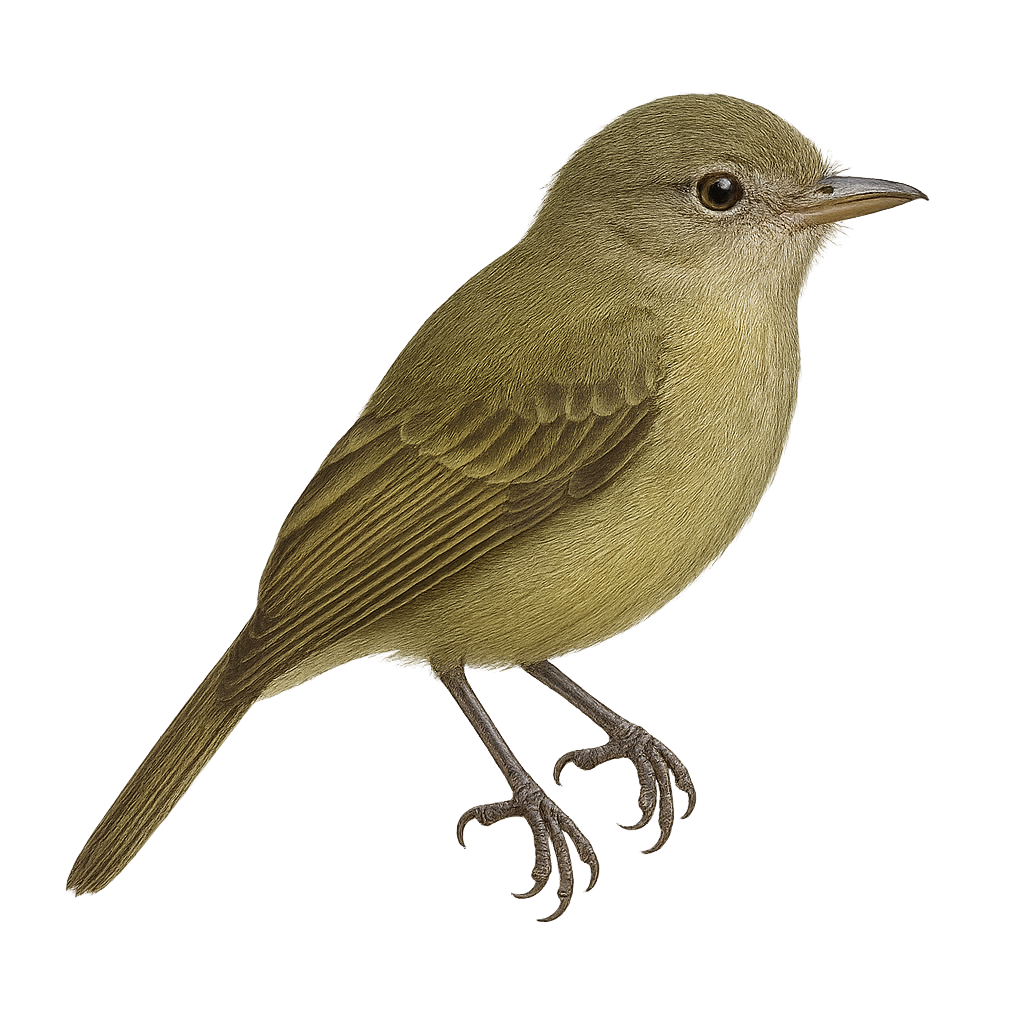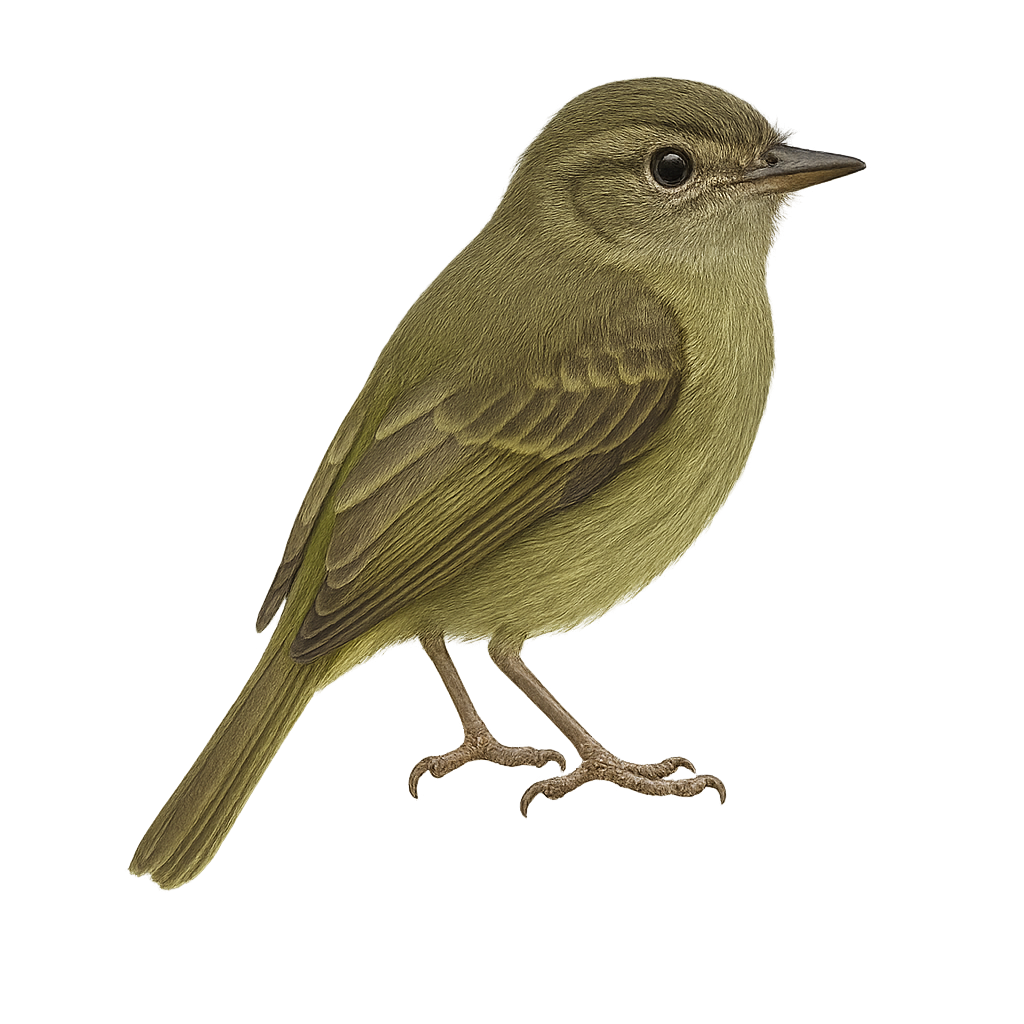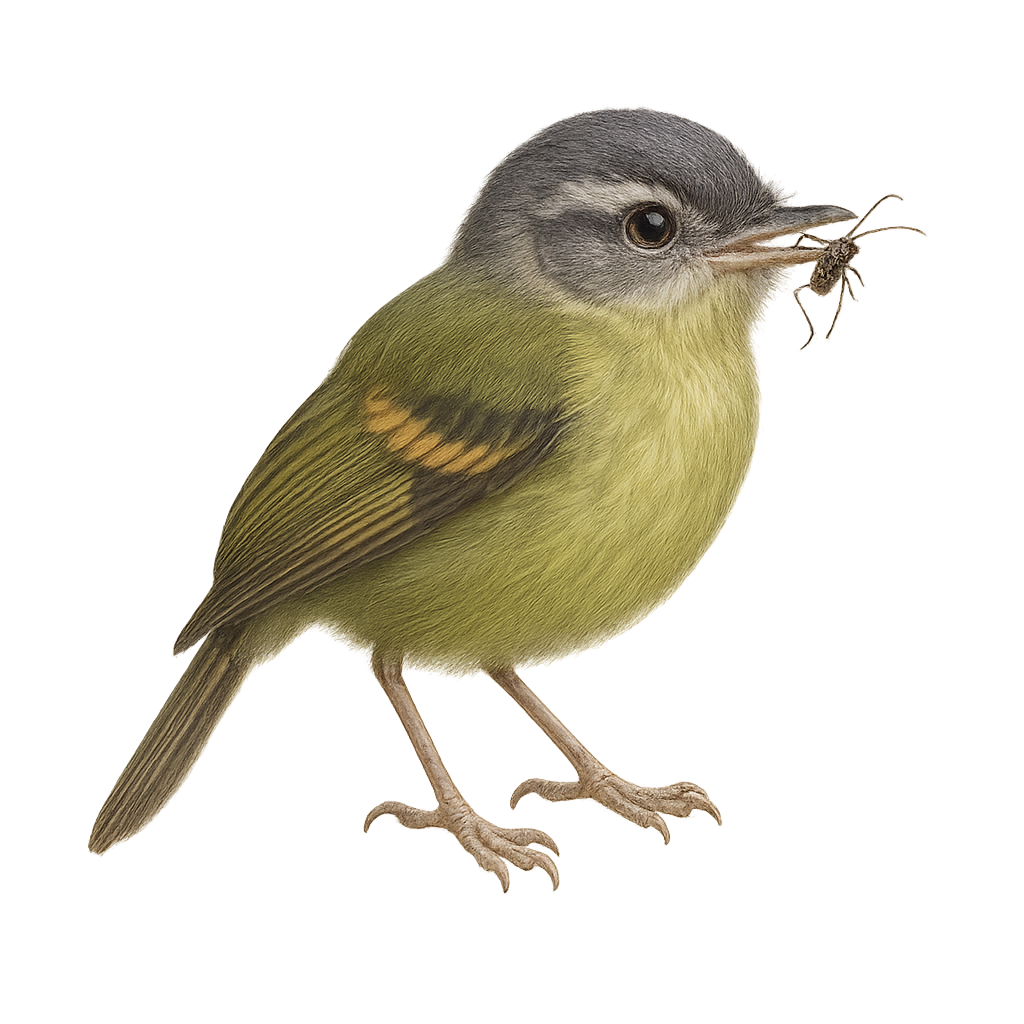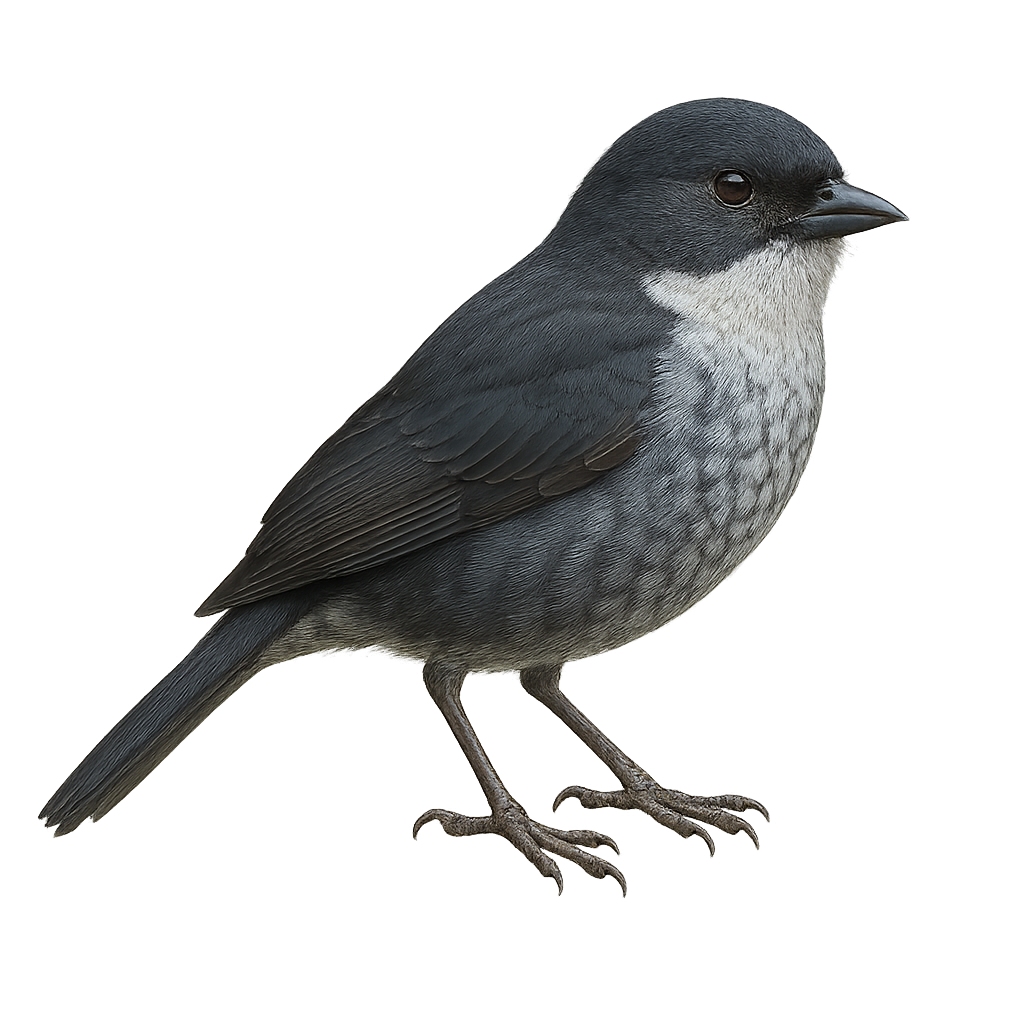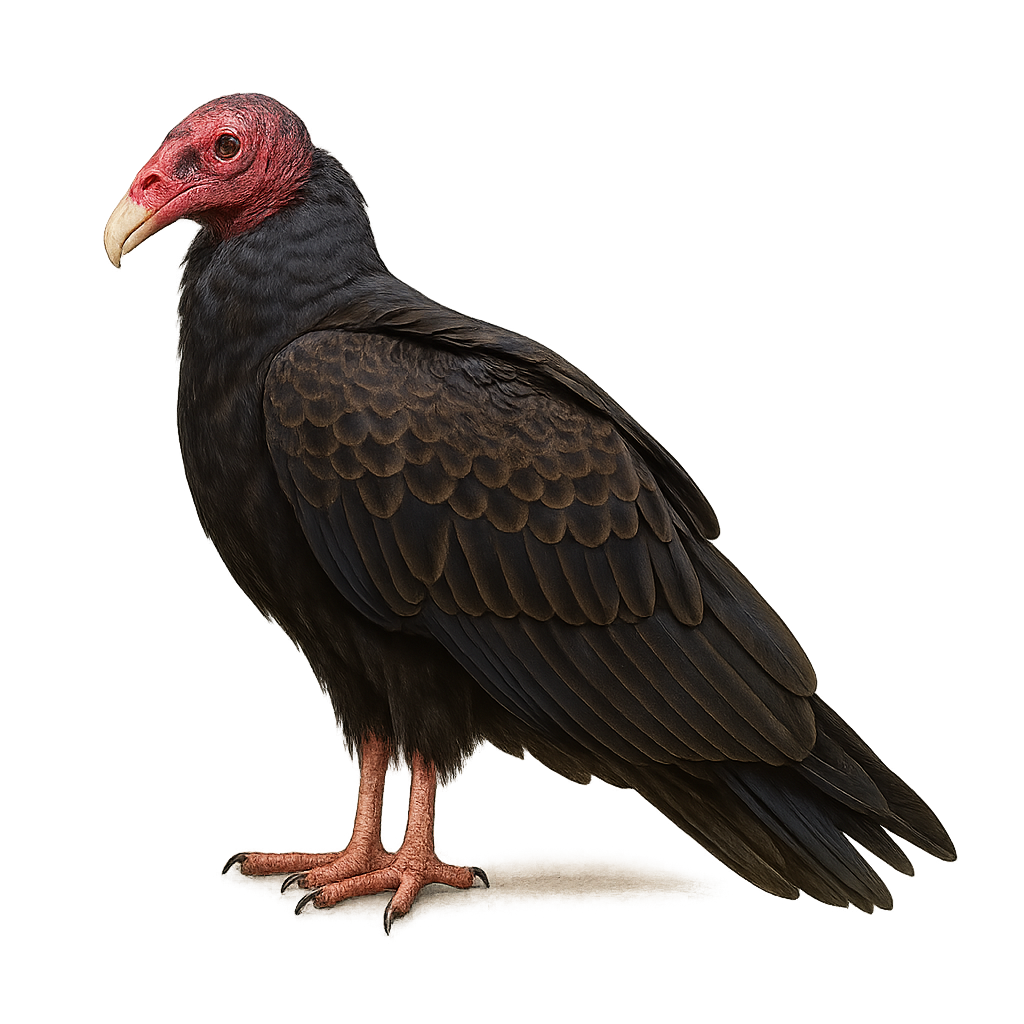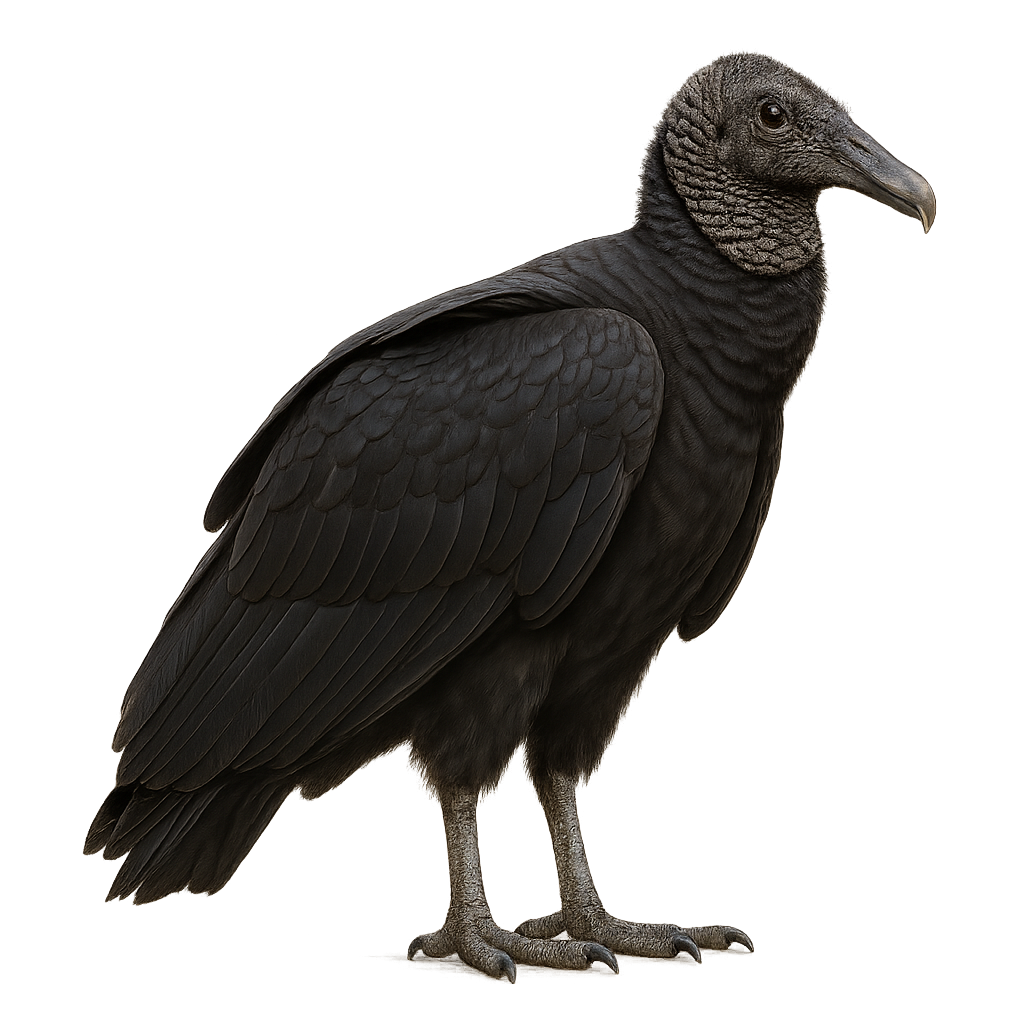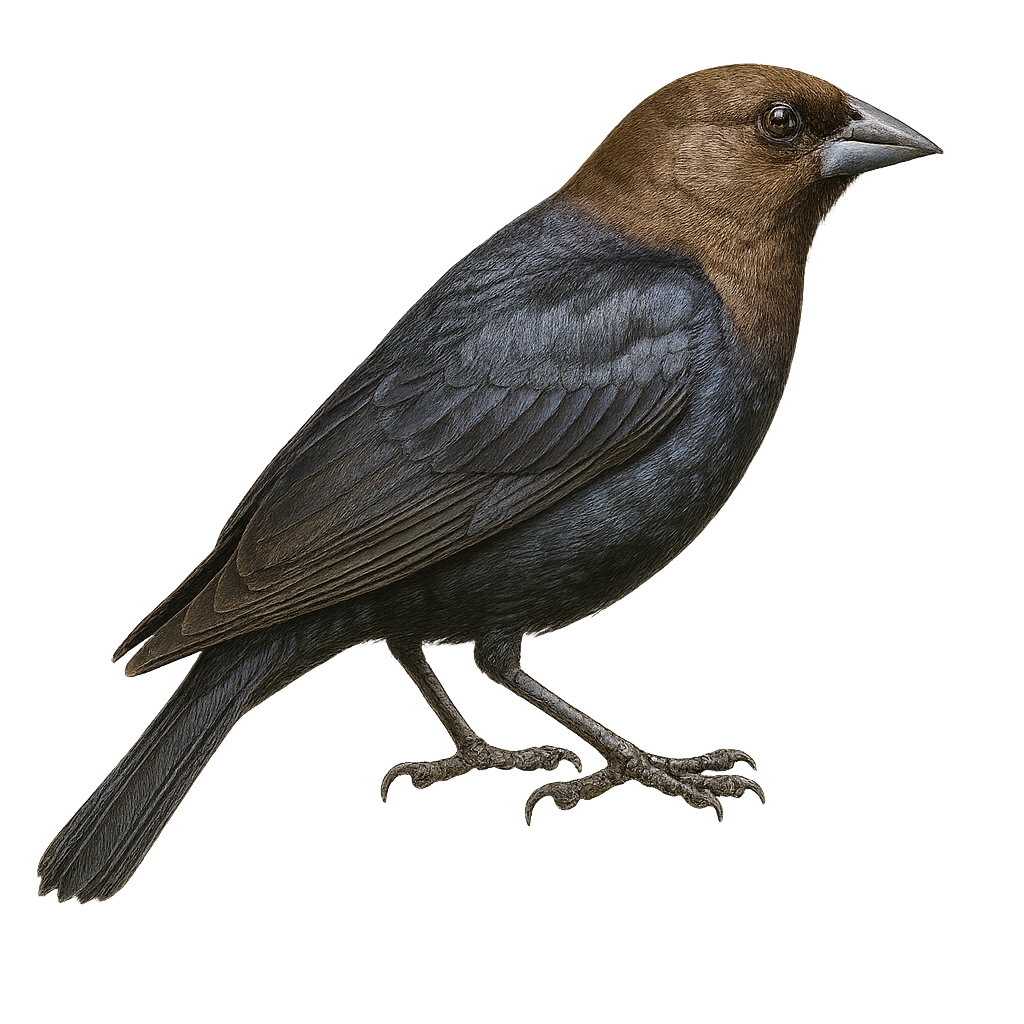The Slender-footed Tyrannulet is a small bird from the Tyrannidae family, primarily found in the humid tropical forests of South America. It is characterized by its modest size, olive-green plumage, and slender legs. Its song is a soft, repetitive trill, often heard before the bird is seen. It feeds mainly on insects, capturing them in flight or by foraging through foliage. This tyrannulet is typically solitary or seen in small family groups. It plays a crucial role in the ecosystem by controlling insect populations. Although its habitat is threatened by deforestation, it is currently listed as a species of least concern by the IUCN.
The Streaked-winged Tyrannulet is a small bird from the Tyrannidae family, commonly found in the humid montane forests of South America. It is characterized by its streaked wings and olive-green plumage. Its modest size and discreet behavior make it sometimes difficult to spot. It primarily feeds on insects, which it catches in flight or by foraging through foliage. Its song is a soft, repetitive trill, often heard before the bird is seen. It is usually solitary or found in small groups and can be observed at altitudes ranging from 1500 to 3000 meters.
The Brown-capped Tyrannulet is a small passerine bird belonging to the Tyrannidae family. It is primarily found in the tropical rainforests of Central and South America, where it moves nimbly through the canopy in search of insects. Its head features a distinctive brownish hue, contrasting with its lighter body. Although discreet, its melodious song makes it identifiable to those who know how to listen. It plays an essential role in the ecosystem by controlling insect populations and participating in the pollination of certain plants. Its small size and lively behavior make it difficult to observe, but it is a favorite subject for amateur and professional ornithologists.
The Ashy-headed Tyrannulet is a small passerine bird belonging to the Tyrannidae family. It is characterized by its ashy gray head contrasting with its olive-green body. This bird is mainly found in humid forests and forest edges, where it feeds on insects and small fruits. It is often identified by its distinctive and melodious song. Although discreet, it is relatively tolerant of human presence, making it easier to observe. Its geographical distribution mainly covers Central and South America, where it inhabits various altitudes. Its population is considered stable, although sometimes threatened by deforestation.
The Black-capped Tyrannulet is a small passerine bird belonging to the Tyrannidae family. It is primarily found in the humid montane forests of South America, notably in Colombia, Peru, and Bolivia. This small bird measures about 11 cm in length and is distinguished by its black cap contrasting with its pale yellow belly and olive-green back. It is often seen foraging for insects in dense foliage. Its song is a high-pitched, repetitive whistle. Although discreet, it is relatively common in its natural habitat. The Black-capped Tyrannulet plays an important role in the ecosystem by controlling insect populations.
The Yellow-bellied Tyrannulet is a small passerine bird from the Tyrannidae family, primarily found in the humid tropical forests of Central and South America. It is characterized by its bright yellow belly, contrasting with an olive-green back and dark wings. This bird is often seen hopping nimbly among branches in search of insects, its main diet. Although discreet, its high-pitched, repetitive song makes it identifiable. It prefers dense wooded areas and is generally wary of humans. Its breeding season varies by region but is often active during the warmer months.
The Gualaquiza Tyrannulet, or Phylloscartes gualaquizae, is a small passerine bird belonging to the Tyrannidae family. It is primarily found in the humid montane forests of Ecuador and Peru. This bird is characterized by its olive-green plumage and distinctive facial markings. Often seen foraging for insects among dense foliage, it is discreet but can be identified by its melodious song. While its population is currently stable, deforestation poses a potential threat to its natural habitat. Preserving these ecosystems is crucial for the survival of this unique species.
The Peters's Tyrannulet, Zimmerius petersi, is a small passerine bird belonging to the Tyrannidae family. It is primarily found in the humid montane forests of South America, particularly in Colombia and Venezuela. This bird is characterized by its olive-green plumage, with lighter shades on the belly and slightly darker wings. Its short, straight bill is adapted to its diet, which mainly consists of insects and small fruits. The song of the Peters's Tyrannulet is a key aspect of its territorial behavior, often heard before the bird is seen. It is usually observed alone or in small groups, actively moving through foliage in search of food.
The Zimmerius bolivianus, or Bolivian Tyrannulet, is a small passerine bird belonging to the Tyrannidae family. It is primarily found in the humid montane forests of the Andean region, particularly in Bolivia and Peru. This bird is characterized by its olive-green plumage on the back and yellow on the belly, with slightly darker wings. It is often seen feeding on insects and small fruits, moving nimbly among the branches. Although discreet, its melodious and repetitive song often reveals its presence. The Bolivian Tyrannulet plays an important role in the ecosystem by contributing to seed dispersal and insect population control.
The Pogonotriccus chapmani, or Chapman's Bristle Tyrant, is a small passerine bird belonging to the Tyrannidae family. It is primarily found in humid montane forests, often at altitudes between 1200 and 2500 meters. This bird is characterized by its olive-green plumage, slightly darker wings, and pale yellow belly. It is often seen in small groups or pairs, feeding on insects caught in flight or on leaves. Although discreet, its melodious and repetitive song can be heard through the canopy. Chapman's Bristle Tyrant is a wary bird, preferring dense areas where it can easily hide. Its conservation status is not concerning, but deforestation could threaten its habitat in the long term.
The Hellmayr's Tyrannulet is a small passerine bird belonging to the Tyrannidae family. It is primarily found in humid montane forests, often at altitudes between 1500 and 3000 meters. This bird features a subtle plumage, mainly olive green with lighter shades on the belly. Known for its distinctive voice, it emits a melodious song that echoes through the dense canopy. Although relatively tolerant, it remains cautious of intruders. Its diet mainly consists of insects, which it captures in flight or by foraging through foliage. The Hellmayr's Tyrannulet plays an important role in the ecosystem by controlling insect populations and aiding in seed dispersal.
The Restinga Tyrannulet, or Phylloscartes kronei, is a small passerine bird endemic to Brazil, primarily found in the coastal forests of the Restinga region. This discreet bird is characterized by its olive-green plumage and white wing markings. It is often seen foraging for insects in dense foliage, moving nimbly from branch to branch. Although not very shy, it remains difficult to spot due to its dense habitat and small size. Preserving its natural habitat is crucial for its survival, as it is threatened by deforestation and increasing urbanization.
The Olive-striped Flycatcher, or Oncostoma olivaceum, is a small passerine bird in the Tyrannidae family. It is primarily found in the humid tropical forests of Central America, particularly in Costa Rica and Panama. This bird is distinguished by its olive-green plumage, which allows it to blend effectively into its natural environment. It measures about 10 to 12 cm in length and primarily feeds on insects caught in flight. The Olive-striped Flycatcher is often seen in pairs or small groups and is known for its melodious and varied songs. Although its habitat is threatened by deforestation, it is currently classified as of least concern by the IUCN.
The Phylloscartes roquettei, known as the Minas Gerais Tyrannulet, is a small bird endemic to Brazil, primarily found in the dry forests and savannas of the Minas Gerais state. It is characterized by its olive-green plumage and slightly darker wings. This discreet bird is often difficult to spot due to its small size and elusive behavior. It primarily feeds on insects, which it catches in flight or on leaves. The Minas Gerais Tyrannulet is an endangered species, mainly due to deforestation and habitat loss. Conserving its habitats is crucial for its long-term survival.
The Parker's Tyrannulet is a small passerine bird belonging to the Tyrannidae family. It is mainly found in the humid montane forests and wooded areas of northern South America, particularly in Colombia and Peru. This passerine is distinguished by its olive-green plumage and slightly darker wings. It is often identified by its distinctive and melodious song. Although discreet, it plays an essential role in the ecosystem by participating in seed dispersal and insect control. The Parker's Tyrannulet is a diurnal bird, active mainly in the morning and late afternoon. Its population is currently stable, but it could be threatened by deforestation.
The Zimmerius albigularis, or White-throated Tyrannulet, is a small passerine bird belonging to the Tyrannidae family. It is primarily found in the humid forests and forest edges of Central and South America, notably in Colombia, Ecuador, and Peru. This bird is distinguished by its white throat contrasting with its olive-green plumage. It is often seen foraging for small insects and spiders in dense foliage. Its song is a soft, melodious trill, often heard before being seen. Although relatively discreet, it plays an important role in the ecosystem by controlling insect populations.
The Planalto Tyrannulet is a small passerine bird belonging to the Tyrannidae family. It is mainly found in the humid forests and forest edges of South America, particularly in Brazil, Argentina, and Paraguay. This bird is characterized by its olive-green back and flanks striped with white and black, providing excellent camouflage in its natural habitat. Its song is a key element for spotting it, as it is often difficult to see due to its small size and discreet behavior. The Planalto Tyrannulet primarily feeds on insects, which it catches in flight or by foraging through foliage.
The Paltry Tyrannulet, Zimmerius vilissimus, is a small passerine bird in the Tyrannidae family. It is primarily found in the humid forests and forest edges of Central America, particularly in Costa Rica and Panama. This small bird measures about 10 to 11 cm in length and is distinguished by its olive-green plumage on the back and pale yellow on the belly. Its short, thick bill is adapted to its diet, which mainly consists of insects and small fruits. The song of the Paltry Tyrannulet is a key aspect of its behavior, often heard before the bird is seen. It is generally solitary or observed in small groups, known for its active and agile behavior, moving quickly through foliage in search of food.
The Northern Beardless Tyrannulet is a small bird from the Tyrannidae family, found mainly in arid and semi-arid regions from the southwestern United States to northern Mexico. It is characterized by its modest size, gray-olive plumage, and lack of a beard, hence its name. This passerine is often seen in low bushes and trees, where it primarily feeds on insects. Its song is a soft, repetitive trill, often heard before the bird is seen. Although discreet, it is quite tolerant of human presence, making it easier to observe.
The Olivaceous Flatbill, or Pogonotriccus ophthalmicus, is a small passerine bird belonging to the Tyrannidae family. This bird is characterized by its olive-green plumage and distinctive white facial markings. It primarily inhabits humid forests and forest edges in mountainous regions of South America, particularly in Colombia, Venezuela, and Ecuador. Its song is a soft, melodious trill, often heard before the bird is seen. The Olivaceous Flatbill is an active insectivore, capturing prey in flight or by foraging through dense foliage. Although relatively discreet, it can be observed in small groups or pairs during the breeding season.
The Ornithion inerme, or white-lored tyrannulet, is a small passerine bird belonging to the Tyrannidae family. It is primarily found in the humid tropical forests of Central and South America, where it feeds on insects and small fruits. This small bird, measuring about 10 cm in length, is distinguished by its olive-green plumage and white markings around its eyes. It is often seen in groups, actively moving through the foliage in search of food. Although relatively common in its habitat, it can be difficult to spot due to its small size and discreet behavior.
The Southern Scrub-Flycatcher, or Sublegatus modestus, is a small passerine bird in the Tyrannidae family. It is primarily found in wooded areas and savannas of South America, particularly in Brazil, Bolivia, and Paraguay. Its plumage is generally dull, with shades of brown and gray, allowing it to blend easily into its surroundings. This small bird is often seen alone or in pairs, feeding on insects it catches in flight. Although discreet, its song is an effective way to spot it. The Southern Scrub-Flycatcher is a diurnal bird, active mainly during the day. It is considered not very shy, making it easier for birdwatchers to observe.
The Burmeister's Tyrannulet, Phyllomyias burmeisteri, is a small bird from the Tyrannidae family. It is primarily found in the subtropical and tropical moist forests of South America, particularly in Brazil, Argentina, and Paraguay. This bird is characterized by its olive-green plumage on the back and pale yellow on the belly, with slightly darker wings. It is often seen in small groups or pairs, feeding mainly on insects caught in flight or on leaves. The song of the Burmeister's Tyrannulet is a soft, repetitive trill, often heard at dawn. Although its habitat is threatened by deforestation, it is currently classified as Least Concern by the IUCN.
The White-throated Tyrannulet, or Mecocerculus minor, is a small bird from the Tyrannidae family. It is primarily found in the humid montane forests of South America, particularly in Colombia, Ecuador, and Peru. This passerine is characterized by its olive-gray plumage and distinctive white throat, which contrasts with the rest of its body. It is often seen in small groups, actively moving in search of insects and other small invertebrates. Its song is a soft, melodious trill, often heard before being seen. Although relatively common in its habitat, it remains discreet and challenging to observe closely.
The Zimmerius improbus, known as the Mistletoe Tyrannulet, is a small passerine bird belonging to the Tyrannidae family. It is primarily found in tropical and subtropical moist lowland forests, often near water. This small bird is distinguished by its olive-green plumage and lighter belly, allowing it to blend into its surroundings. It is known for its melodious song and varied vocalizations, often heard before being seen. The Mistletoe Tyrannulet is an active bird, spending most of the day foraging for insects and fruits in the canopy. Although its habitat is threatened by deforestation, it is currently classified as Least Concern by the IUCN.
The Restinga Tyrannulet, or Pogonotriccus poecilotis, is a small passerine bird belonging to the Tyrannidae family. It is primarily found in the subtropical and tropical moist forests of southeastern Brazil. This bird is characterized by its striped black and white head, olive-green back, and pale yellow belly. It is often seen foraging for insects in dense foliage, moving with agility and speed. Although discreet, its melodious and repetitive song can be heard throughout the canopy. The Restinga Tyrannulet is not very shy, making it easier for birdwatchers to observe.
The Stolzmann's Tanager is a medium-sized bird, measuring about 15 cm in length. It features predominantly black plumage with bluish sheen and a distinctive white cap. This bird is endemic to the Andes, mainly in Colombia and Ecuador, where it inhabits cloud forests and high-altitude shrublands. It is often seen in small groups, feeding on insects and fruits. Although its habitat is relatively restricted, it is not considered threatened. However, deforestation poses a potential threat to its populations. The Stolzmann's Tanager is an active and vocal bird, often detected by its melodious song and distinctive calls.
The Turkey Vulture, or Cathartes aura, is a large scavenging bird of prey native to the Americas, easily identified by its red, featherless head and dark brown plumage. It plays a vital role in the ecosystem by consuming carrion, thus helping to prevent the spread of disease. With an excellent sense of smell, it can detect gases emitted by decaying carcasses. In flight, it is often seen soaring with its wings in a V-shape, using thermal updrafts to conserve energy. Although typically solitary, it can gather in large groups to feed. Its ability to adapt to various habitats, from forests to deserts, makes it a resilient and widespread bird.
The Black Vulture, or Coragyps atratus, is a medium-sized scavenger bird, easily recognized by its entirely black plumage and grayish bare head. It is often seen soaring with its broad, short wings and is distinguished by its short, square tail. This bird is widespread across the Americas, from the southern United States to Argentina. It inhabits various environments, from forests to urban areas, and plays a crucial ecological role by disposing of carcasses. Although often seen in large groups, the Black Vulture is somewhat wary of humans. Its ability to adapt to different environments and feed on various food sources makes it a resilient species.
The Brown-headed Cowbird, Molothrus ater, is a passerine bird from the Icteridae family, native to North America. This bird is easily recognizable by its chocolate-brown head contrasting with its glossy black body in males, while females have a duller, grayish-brown plumage. The Brown-headed Cowbird is known for its brood parasitism behavior, laying its eggs in the nests of other bird species, which can negatively impact host populations. It inhabits various environments, including grasslands, agricultural areas, and forest edges. Although often considered a nuisance by birdwatchers, it plays a role in ecological balance by controlling insect populations.


